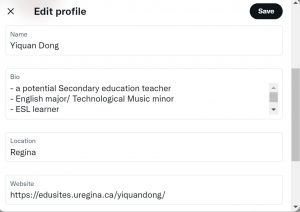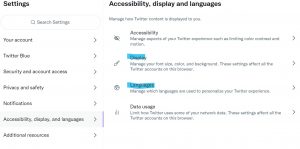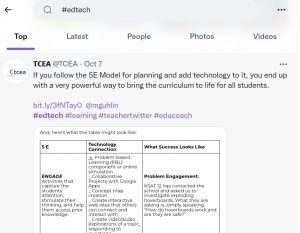I decided to use the Q & A form to share my experiences with Twitter. And I highlight the keypoints in colors, hope colors help you navigate this long post more easily.
Q: Have you used Twitter?
A: Yes.
Q: How did you use it in the past?
A:
I lurked on Twitter. I know that Twitter is a famous digital media platform where people can catch up with the news about big international events and first-hand professional comments made by well-known politicians. However, I am not into politics. The reason I downloaded it was merely to follow the trend. My classmates in high school would tease Donald Trump’s tweets at the time his account was valid. My friends said his writing style on Twitter was wild and very different from the implicit styles of other politicians. To keep up with this kind of conversation, I created an account and Donald Trump was the only one I followed.
I positioned myself as an audience. In another word, I neither had interactions with other users nor made any comments on others’ tweets.
Q: How are you using it in the present?
A:
I use it to build my online identity. I created a new account to distinguish between a random user and an educator.
When I set up the new account, the system asked me to select the domains I have interests in and I chose “education”. Looking at the blank follower and following list, I edited my profile first which is the most visible place to demonstrate one’s identity because it will be shown under the user’s handles in the suggested list. My biography goes with bullet points and concise language. I also linked my E-portfolio to my account, which made people easily transfer from one field to another:

My profile
For me, identity is not only about things I show to others but also about the contents I show to myself. Therefore, I did some personal settings such as changing the display color and preferred language:

How to change language and display color on Twitter?
My next step was to create a personal learning network (PLN). I followed up with some classmates on the Twitter list. At the time I clicked the “follow” button, I saw their profiles, knew their identities, and learned from their presenting ways. In this step, I experienced the personal part of PLN because I chose the targets I wanted to learn from. Sooner, I found other users, whose tweets fit into my learning focus, in my classmates’ following list and suggested user list. This is the network because people are connecting because of the same learning focus and Twitter’s algorithm.
After building my profile and follower lists, I began to share my learning by tweeting and re-tweeting. This step expanded my network because of the use of hashtags. Via searching for hashtags, you will find a number of tweets that have the same focus as yours:

The use of a hashtag
You can follow those tweets’ authors if you have a big resonance with their content.
In sum, Twitter is like a database for me. However, it is different from the library database which most of the contents are academic and official, the educational resources on Twitter are fresh and ongoing. It can be a thought-provoking question or a visual-friendly form with illustrations. I need not worry much about the writing style when I post a tweet, which gives me a chance to focus more on sharing my stories and experiences.
Q: In what ways do you find Twitter useful/not useful?
A:
I like Twitter because I can share my opinions simultaneously. For example, when I read a meaningful article and I want to share it, I can copy its URL and paste it into a new tweet. The amazing thing is that the paste link will change into a link with an attractive photo. I can also get the most up-to-date information from people in PLN. People generate ideas and post them. Then viewers can read their tweets as soon as they are posted. I like the tweet which consists of an open-ended question. When people give answers, a talking circle and collective learning environment appear. I broaden my sight when I read people’s comments. Twitter redefines the edge of the classroom. It allows people to communicate regardless of district restrictions.
It is easy to form a learning network. Sitting at home, I can learn from different perspectives by clicking the mouse. I do not need to meet professionals in person because I could find their speeches and personal website on their Twitter accounts. Twitter makes resources accessible.
Twitter is useful for self-regulated learning. I am flexible in my learning places and time. I can log onto my Twitter account on my phone and learn from the world when I am on the bus. I am flexible to choose my learning focus by selecting the domains I am interested in. I am flexible to switch states between lurking and sharing which means that I can choose either to be a listener or a speaker completely according to my will.
Twitter has some drawbacks, just as a coin has two sides.
Its commercial characteristic leads to the frequent emergence of pop-ups which interferes with people’s browsing experience.
As people tweet and retweet frequently, they get fewer chances for immersive reading. I would say the information on Twitter is so fragmented that we pass quickly from one page to the next and gradually lose interest to dig deeply into one resource.
The content is unsifted which gives bad people opportunities to spread negative information that jeopardizes the online environment.
Q: What Twitter might look like in your future classroom?
A:
I like the definition of PLN. Therefore, I might follow the use of Twitter in the EDTC300 course to create a learning community on Twitter in my future classroom. Students are welcome to share their opinions and stories in informal ways on Twitter. Under teachers’ and parents’ guidance, students will use the search function to dig into their interests.
However, as Twitter is available for everyone and my students are vulnerable youth, I will accompany them in their every step of exploring Twitter. For example, I will create a filter for sensitive words to prevent them from appearing in students’ Twitter accounts. I will also enhance communication with parents to ensure that students use this digital media in the right way. I can also use the learning community on Twitter as a technology place for the class to think critically about the pros and cons of social media.

Hi Yiquan!
That is a great approach in doing it in Question and Response format. Your post is well organized and has most most of your experiences with Twitter highlighted. By the way, have you ever thought on how will be using it in your future classroom?. This is something to consider. Thanks for sharing.
Thank you for your structured comment! In the future classroom, I may allow students to explore Twitter and write a review of their user experience. The requirement will be writing three pros and three cons based on your observation. How do you think about this idea? Thank you, Jean-Paul!